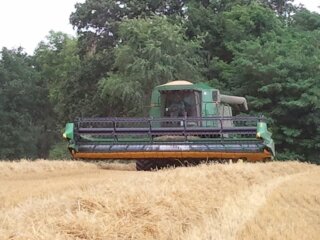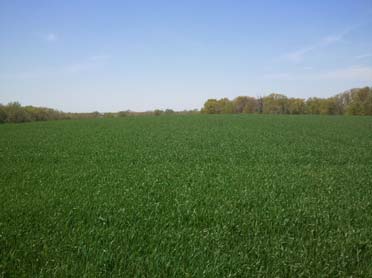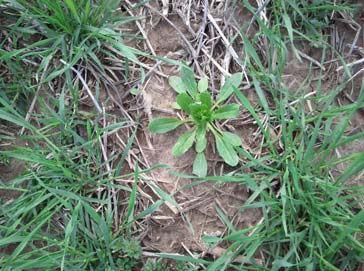 Question: What should your goal(s) be when planning for the best possible outcome of the wheat crop that you are going to plant this fall?
Question: What should your goal(s) be when planning for the best possible outcome of the wheat crop that you are going to plant this fall?
If you answered 100 bushel per acre yield, then here are some ideas that can help reach that goal.
- Plant timely and do a good job! Use high quality seed wheat and choose a good variety. If planning on using bin run seed, it should be germ tested, cleaned, and if possible, a good seed treatment applied. Seeding rates varies depending on the seed quality, soil moisture, planting date, and if treated seed is being used. We are using 120 pounds per acre in 8 inch drill rows everywhere we no-till after soybeans on our farm.
- Maximize number of tillers! You want to have a minimum of 70 tillers per square foot going into the spring green-up. This starts in the fall by doing a good job of drilling the wheat and having the proper fertility in the field.
 Manage nutrients efficiently! Wheat doesn’t need a lot of nutrients in the fall. However, to maximize yield potential, it does need phosphorus to build its root system and begin to tiller in the fall. Cooler soil temperature in the fall as the wheat plant is getting started, makes it difficult for the wheat roots to take up enough phosphorus from the soil. In lower P testing soils, there can be a tremendous yield response by adding phosphorus fertilizer at planting. Kansas State recommends placing P fertilizer with the seed. This is the most efficient way to get the nutrients to the plant early in the plants life.
Manage nutrients efficiently! Wheat doesn’t need a lot of nutrients in the fall. However, to maximize yield potential, it does need phosphorus to build its root system and begin to tiller in the fall. Cooler soil temperature in the fall as the wheat plant is getting started, makes it difficult for the wheat roots to take up enough phosphorus from the soil. In lower P testing soils, there can be a tremendous yield response by adding phosphorus fertilizer at planting. Kansas State recommends placing P fertilizer with the seed. This is the most efficient way to get the nutrients to the plant early in the plants life.
CROP CHOICE 6-24-6-1, at 5-7 gallons per acre would be an economical way to do this, and it would be 40 more times more effective than a broadcast application before planting (not to mention save a trip over the field – reducing compaction and saving fuel).
 Time nutrient applications for maximum efficiency! In the early spring (February/March), top dress with a portion of your nitrogen. If 100 bushels per acre is your yield goal, the total N needs for that plant is going to be at least 100 pounds of nitrogen fertilizer. Splitting this in a minimum of two applications is best. This past wheat season, two of our wheat growers applied their top dress nitrogen in late February while the ground was still frozen. One used 50 units of dry N, the other with 75 units. The first came in at green-up and applied 3 gallons of Crop Choice Foliar Opp for wheat and 2 gallons of SRN 28/72 along with Harmony Herbicide to control winter annuals and other weeds present in the field. The second grower just sprayed Harmony. Then at the flag leaf stage of the wheat, they both applied 2 more gallons SRN 28/72 along with fungicide, one using a ground rig, the other aerial applied. Both producers reported fields that produced 90 bushels per acre average yields.
Time nutrient applications for maximum efficiency! In the early spring (February/March), top dress with a portion of your nitrogen. If 100 bushels per acre is your yield goal, the total N needs for that plant is going to be at least 100 pounds of nitrogen fertilizer. Splitting this in a minimum of two applications is best. This past wheat season, two of our wheat growers applied their top dress nitrogen in late February while the ground was still frozen. One used 50 units of dry N, the other with 75 units. The first came in at green-up and applied 3 gallons of Crop Choice Foliar Opp for wheat and 2 gallons of SRN 28/72 along with Harmony Herbicide to control winter annuals and other weeds present in the field. The second grower just sprayed Harmony. Then at the flag leaf stage of the wheat, they both applied 2 more gallons SRN 28/72 along with fungicide, one using a ground rig, the other aerial applied. Both producers reported fields that produced 90 bushels per acre average yields.
Another producer called and wanted to start planning for next year’s application of fungicide, because he used a UAN solution with his fungicide and burnt his wheat, taking a hit in yield because of it. If you do use UAN solutions for top dressing, use streamers, don’t broadcast apply the N, and don’t use herbicides with it that will increase the chance of damage.
- Scout for insects, weeds, and disease, then apply insecticide, herbicide fungicide at correct stage!
This should be started in the fall, as soon as the wheat emerges. High yielding wheat producers are applying a fall herbicide and insecticide to control aphids and winter annuals. If doing this, FOLIAR OPP for wheat can be added to the mix.
This is a great way to add extra N-P-K and micro nutrients, making the wheat just that much stronger going into winter. Since the trip is being made, why not add fertilizer?
Controlling weeds early in the spring is essential! Marestail, henbit, chickweed are winter annuals which get started in the fall, then come on strong in the spring and summer, robbing nutrients and wheat yields. An application of a wheat herbicide like Harmony will stop them. This is the perfect time to apply 2-5 gallons of SRN 28/72. SRN will not burn the wheat and used along with SO-IL BOOST PLUS & LANDOIL, the weeds will be controlled much better.
Since the soil and air temperatures are cooler when it’s time to make this application, adding 3 gallons per acre of CROP CHOICE FOLIAR OPP for wheat will help those wheat plants be more efficient in taking up soil nutrients.
- Use appropriate SO-IL Service Products with herbicides and fungicides! The right products used at the correct time, can make all the difference when going for high yielding wheat. With our lineup of products, we can help any producer start achieving high yielding wheat (with just a little help from Mother Nature).
- CROP CHOICE STARTER FERTILIZER – 6-24-6-1 for wheat in furrow with the wheat seed is safe to the seed and gives the added phosphorous that the wheat needs to build its root system before winter.
- SO-IL BOOST PLUS – buffers the water used for spraying. Also increases the absorption and translocation of foliar fertilizers and pesticides.
- LANDOIL – increases penetration of fertilizers and pesticides, makes more uniform spray droplets and spray patterns, reduces drift, and makes everything rain fast in twenty minutes.
- CROP CHOICE FOLIAR OPP for wheat – excellent addition of N-P-K-S & micronutrients, making the plants more efficient in taking up other nutrients.
- SRN 28/72 – very, very safe form of nitrogen which does not burn the crop and can be added to any insecticide, herbicide, and fungicide application for a supplemental nitrogen application during the growing season.
- Equipment to apply with drills and/or planters. SO-IL Service can help you get the right equipment to apply starter on your wheat. Let us know and we can help you get started reaching that goal of high yielding wheat.
If you are coming to the FARM PROGRESS SHOW later this month in Boone, Iowa, stop by our booth, 1310 and let’s visit.
John Viertel
573-680-6951 (voice and text)
